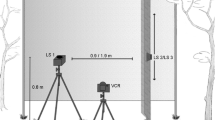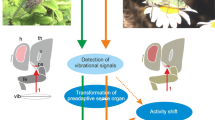Abstract
The phonotactic capacity of tachinid flies to acoustically detect and localize a sound source simulating their cricket host was investigated in a large flight room. Acoustic measurements were performed to estimate the actual stimulus delivered to the flies, revealing highly heterogeneous sound fields. When presented with a simulated cricket song in red or infrared light conditions, the flies readily flew to the sound source and landed on it. Behavioural phonotactic thresholds were established as a function of carrier frequency and were found to coincide well with the frequency of the host's natural song (4.5–5.2 kHz). Experiments revealed that the same range of frequencies is preferentially attractive to the free-flying flies, and that the reliability of signal detection in the presence of noise is best at behaviourally relevant frequencies.
Similar content being viewed by others
Author information
Authors and Affiliations
Additional information
Received: 23 February 2000 / Accepted in revised form: 6 June 2000
Rights and permissions
About this article
Cite this article
Ramsauer, N., Robert, D. Free-flight phonotaxis in a parasitoid fly: behavioural thresholds, relative attraction and susceptibility to noise. Naturwissenschaften 87, 315–319 (2000). https://doi.org/10.1007/s001140050729
Issue Date:
DOI: https://doi.org/10.1007/s001140050729




